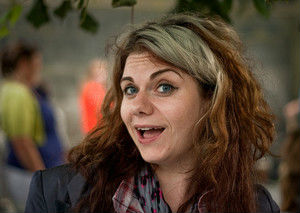Caitlin Moran made a splash two years ago with her book of essays, How to Be A Woman. While better known in England than here in the States, her body of work so far will hopefully rectify that. How to Be a Woman goes roughly in chronological order, from Moran's burgeoning adolescence in Wolverhampton to contemplating her mortality since she is not really "young" anymore. Proudly owning the title "strident feminist," Moran explains wittily, if not always calmly, why the world needs feminism. Moran defines feminism as "everyone being polite to one another," and goes on to describe what that entails. Did I mention she was witty? Moran is hilarious, especially when you think she might blow a gasket. She is not afraid of capital letters or exclamation points. While Moran hits the feminist bailiwicks like pornography, abortion, etc., she does it with far more humor than one might expect, given the fact she is also very insightful.
Moran's second foray across the pond is Moranthology. This is Moran doing what got her famous: columns for the Times. The book is divided into sections, each preceded by a scene between Moran and her husband that solidifies her reputation for male-female humor and his saintliness. Among the more memorable columns is one on Lady Gaga (expanded from How to Be a Woman) and another on the value of libraries, which should be required reading for any politician who sees public libraries as a source of "savings;" I nearly cried at the end of it. Moran's romps through pop culture are expectedly hilarious, whether lusting after Benedict Cumberbatch, sneering at Downton Abbey, or covering the latest royal wedding from her couch. Definitely good reading for the train, especially if you want to sit alone because you are that weirdo who laughs too much.
Moran's latest effort is a novel: How to Build A Girl. Johanna Morrigan is growing up in a council estate (housing project) in a British industrial city in the early 1990's. After blowing an interview on national television (she won a writing contest and then acts like, well, the teenager she is), Morrigan decides to reinvent herself. She becomes Dolly Wilde and lands a job as a rock critic, eviscerating every band that does not meet her expectations, that is to say, pretty much all of them. Never far away is the fact that her parents barely have the means to put food on the table and some kind of clothing on their children. Despite this, Morrigan/Wilde has a grand time going to concerts, ingesting controlled substances, and shagging whomever she can. Well, the shagging is not always a grand time, which leads to some of the funniest and saddest parts of the book. It all falls apart when Morrigan realizes she's not only feared but actively disliked throughout the music community, and has to rebuild herself and her professional reputation. This book is an excellent look at a particular time and place, and what it was like to be young then. You can feel every cheap fabric, every wintry splash from the bus, every pounding of the drums through a PA system. This novel requires a little more commitment than Moran's nonfiction, but is worth every minute you spend with it.




Add a comment to: Moran More